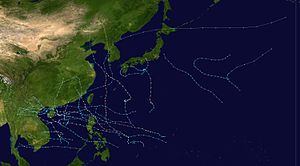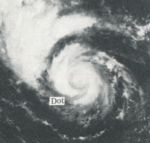1973 Pacific typhoon season
| 1973 Pacific typhoon season | |
|---|---|
 Season summary map | |
| Seasonal boundaries | |
| First system formed | June 30, 1973 (record latest) |
| Last system dissipated | November 27, 1973 |
| Strongest storm | |
| Name | Nora |
| • Maximum winds | 295 km/h (185 mph) (1-minute sustained) |
| • Lowest pressure | 877 hPa (mbar) |
| Seasonal statistics | |
| Total depressions | 25 |
| Total storms | 21 |
| Typhoons | 12 |
| Super typhoons | 3 (unofficial) |
| Total fatalities | Unknown |
| Total damage | Unknown |
| Related articles | |
The 1973 Pacific typhoon season was the latest start to the typhoon season on record. It had no official bounds, but most tropical cyclones tend to form in the northwestern Pacific Ocean between June and December. These dates conventionally delimit the period of each year when most tropical cyclones form in the northwestern Pacific Ocean.
The scope of this article is limited to the Pacific Ocean, north of the equator and west of the international date line. Storms that form east of the date line and north of the equator are called hurricanes; see 1973 Pacific hurricane season. Tropical Storms formed in the entire west pacific basin were assigned a name by the Joint Typhoon Warning Center. Tropical depressions in this basin have the "W" suffix added to their number. Tropical depressions that enter or form in the Philippine area of responsibility are assigned a name by the Philippine Atmospheric, Geophysical and Astronomical Services Administration or PAGASA. This can often result in the same storm having two names.
Systems
25 tropical depressions formed this year in the Western Pacific, of which 21 became tropical storms. 12 storms reached typhoon intensity, of which 3 reached super typhoon strength.[1]
Tropical Storm Wilda (Atring)
| Tropical storm (SSHWS) | |
| Duration | June 30 – July 6 |
|---|---|
| Peak intensity | 110 km/h (70 mph) (1-min); 980 hPa (mbar) |
Typhoon Anita
| Category 1 typhoon (SSHWS) | |
| Duration | July 5 – July 10 |
|---|---|
| Peak intensity | 130 km/h (80 mph) (1-min); 980 hPa (mbar) |
Tropical Storm Clara
| Tropical storm (SSHWS) | |
| Duration | July 12 – July 15 |
|---|---|
| Peak intensity | 100 km/h (65 mph) (1-min); 985 hPa (mbar) |
Super Typhoon Billie (Bining)
| Category 4 super typhoon (SSHWS) | |
| Duration | July 12 – July 20 |
|---|---|
| Peak intensity | 240 km/h (150 mph) (1-min); 915 hPa (mbar) |
Tropical Storm Bille, which developed on July 12 east of the Philippines, rapidly strengthened on the 14th and 15th to a 150 mph super typhoon. It tracked due north, fluctuating in intensity for the next 3 days. A building ridge over the Sea of Japan forced Billie to the northwest, where it weakened greatly, first to a tropical storm on the 18th, then to a tropical depression on the 19th as it passes over northeastern China. The storm dissipated on the 20th.
Typhoon Dot
| Category 2 typhoon (SSHWS) | |
| Duration | July 13 – July 21 |
|---|---|
| Peak intensity | 155 km/h (100 mph) (1-min); 975 hPa (mbar) |
Typhoon Dot struck Hong Kong causing sustained storm force winds, killing one person.[2]
Typhoon Ellen
| Category 3 typhoon (SSHWS) | |
| Duration | July 17 – July 29 |
|---|---|
| Peak intensity | 195 km/h (120 mph) (1-min); 940 hPa (mbar) |
Tropical Storm Fran (Kuring)
| Tropical storm (SSHWS) | |
| Duration | July 27 – July 30 |
|---|---|
| Peak intensity | 75 km/h (45 mph) (1-min); 1000 hPa (mbar) |
Typhoon Georgia
| Category 1 typhoon (SSHWS) | |
| Duration | August 8 – August 15 |
|---|---|
| Peak intensity | 130 km/h (80 mph) (1-min); 980 hPa (mbar) |
Tropical Storm Hope
| Tropical storm (SSHWS) | |
| Duration | August 8 – August 13 |
|---|---|
| Peak intensity | 85 km/h (50 mph) (1-min); 1000 hPa (mbar) |
Typhoon Iris (Daling)
| Category 2 typhoon (SSHWS) | |
| Duration | August 9 – August 20 |
|---|---|
| Peak intensity | 155 km/h (100 mph) (1-min); 970 hPa (mbar) |
Tropical Depression 11W
| Tropical depression (SSHWS) | |
| Duration | August 12 – August 18 |
|---|---|
| Peak intensity | 55 km/h (35 mph) (1-min); 1005 hPa (mbar) |
Tropical Storm Joan (Elang)
| Tropical storm (SSHWS) | |
| Duration | August 17 – August 22 |
|---|---|
| Peak intensity | 85 km/h (50 mph) (1-min); 990 hPa (mbar) |
Tropical Depression Goring
| Tropical depression (PAGASA) | |
| Duration | August 20 – August 22 |
|---|---|
| Peak intensity | 55 km/h (35 mph) (10-min); |
Tropical Storm Kate
| Tropical storm (SSHWS) | |
| Duration | August 23 – August 27 |
|---|---|
| Peak intensity | 110 km/h (70 mph) (1-min); 975 hPa (mbar) |
Tropical Depression 14W
| Tropical depression (SSHWS) | |
| Duration | August 31 – September 3 |
|---|---|
| Peak intensity | 55 km/h (35 mph) (1-min); |
Typhoon Louise (Huling)
| Category 1 typhoon (SSHWS) | |
| Duration | September 2 – September 9 |
|---|---|
| Peak intensity | 140 km/h (85 mph) (1-min); 975 hPa (mbar) |
Typhoon Marge (Ibiang)
| Category 1 typhoon (SSHWS) | |
| Duration | September 11 – September 16 |
|---|---|
| Peak intensity | 150 km/h (90 mph) (1-min); 965 hPa (mbar) |
Hainan, Qionghai Jiaji town recorded a minimum central pressure of 937.8 hPa when Marge landfall.Marge killed 903 people in Hainan.
Super Typhoon Nora (Luming)
| Category 5 super typhoon (SSHWS) | |
| Duration | October 2 – October 10 |
|---|---|
| Peak intensity | 295 km/h (185 mph) (1-min); 877 hPa (mbar) |
The monsoon trough spawned a tropical depression east of the Philippines on October 1. Under weak steering currents, it meandered westward, where favorable conditions allowed for it to strengthen, first to a tropical storm on the 2nd, then to a typhoon on the 3rd. Nora continued to the northwest, and explosively deepened on the 5th and 6th to a 185 mph super typhoon. At the time, it had a minimum central pressure of 877 millibars, the lowest pressure on record at the time and currently tied for 9th. The typhoon weakened as it headed to the northwest, and struck northeastern Luzon on the 7th as a 115 mph typhoon. Nora continued to the northwest, weakening to a minimal typhoon as it hit southeast China on the 10th. The typhoon caused 18 fatalities, with over $2 million in damage.
Typhoon Opal
| Category 1 typhoon (SSHWS) | |
| Duration | October 4 – October 9 |
|---|---|
| Peak intensity | 140 km/h (85 mph) (1-min); 970 hPa (mbar) |
Super Typhoon Patsy (Miling)
| Category 5 super typhoon (SSHWS) | |
| Duration | October 6 – October 15 |
|---|---|
| Peak intensity | 260 km/h (160 mph) (1-min); 895 hPa (mbar) |
Typhoon Ruth (Narsing)
| Category 2 typhoon (SSHWS) | |
| Duration | October 11 – October 21 |
|---|---|
| Peak intensity | 165 km/h (105 mph) (1-min); 960 hPa (mbar) |
27 people were killed when Typhoon Ruth crossed Luzon on October 15 and caused $5 million in damage. Ruth continued to the northwest, and hit Hainan Island and China on the 19th and 20th, respectively.
Tropical Storm Sarah
| Tropical storm (SSHWS) | |
| Duration | November 9 – November 12 |
|---|---|
| Peak intensity | 100 km/h (65 mph) (1-min); 985 hPa (mbar) |
On November 12 this system emerged in the Bay of Bengal and became Tropical Cyclone 37-73.[1]
Tropical Storm Thelma
| Tropical storm (SSHWS) | |
| Duration | November 14 – November 18 |
|---|---|
| Peak intensity | 100 km/h (65 mph) (1-min); 990 hPa (mbar) |
Tropical Storm Vera (Openg)
| Tropical storm (SSHWS) | |
| Duration | November 19 – November 27 |
|---|---|
| Peak intensity | 95 km/h (60 mph) (1-min); 990 hPa (mbar) |
One of the strongest tropical cyclones to hit Visayas when it entered on November 20. Tropical Storm Openg affected around 3.4 million people.[3]
Storm names
Western North Pacific tropical cyclones were named by the Joint Typhoon Warning Center. The first storm of 1973 was named Wilda and the final one was named Vera.
|
|
|
|
Philippines
| Atring | Bining | Kuring | Daling | Elang |
| Goring | Huling | Ibiang | Luming | Miling |
| Narsing | Openg | Pining (unused) | Rubing (unused) | Saling (unused) |
| Tasing (unused) | Unding (unused) | Walding (unused) | Yeyeng (unused) | |
| Auxiliary list | ||||
|---|---|---|---|---|
| Anding (unused) | ||||
| Binang (unused) | Kadiang (unused) | Dinang (unused) | Epang (unused) | Gundang (unused) |
The Philippine Atmospheric, Geophysical and Astronomical Services Administration uses its own naming scheme for tropical cyclones in their area of responsibility. PAGASA assigns names to tropical depressions that form within their area of responsibility and any tropical cyclone that might move into their area of responsibility. Should the list of names for a given year prove to be insufficient, names are taken from an auxiliary list, the first 10 of which are published each year before the season starts. This is the same list used for the 1969 season. PAGASA uses its own naming scheme that starts in the Filipino alphabet, with names of Filipino female names ending with "ng" (A, B, K, D, etc.).
See also
References
- ^ a b "1973 ATCR TABLE OF CONTENTS". Archived from the original on 2011-06-06. Retrieved 2009-12-25.
{{cite web}}: Unknown parameter|dead-url=ignored (|url-status=suggested) (help) - ^ Historical Information
- ^ de la Cruz, Gwen; Romulo, Mica (August 2, 2014). "Worst natural disasters in the Philippines". Rappler. Rappler. Retrieved March 2, 2016.
External links
- Japan Meteorological Agency
- Joint Typhoon Warning Center.
- China Meteorological Agency
- National Weather Service Guam
- Hong Kong Observatory
- Macau Meteorological Geophysical Services
- Korea Meteorological Agency
- Philippine Atmospheric, Geophysical and Astronomical Services Administration
- Taiwan Central Weather Bureau
- Digital Typhoon - Typhoon Images and Information
- Typhoon2000 Philippine typhoon website








































